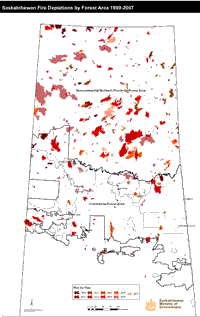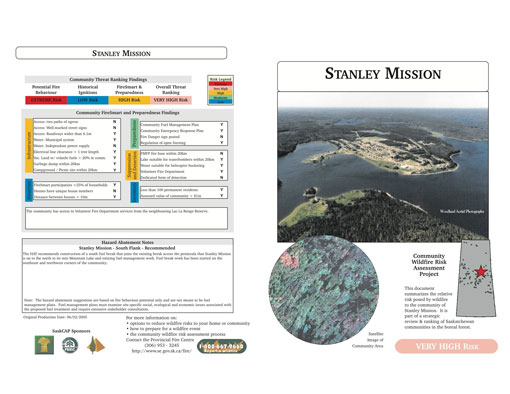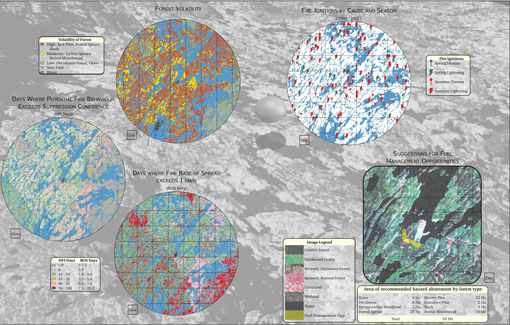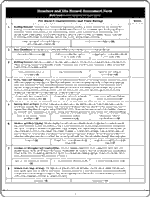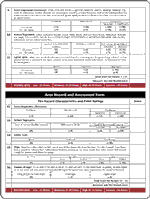Reducing the Wildfire Risk
The FireSmart program
Nearly 50% of Saskatchewan is covered in forest. It is important habitat to native biodiversity, including wildlife. The northern boreal forest is home to northern residents and provides them with various levels of livelihood. It is also important to the forest industry and a variety of mining interests. Small island forests also exist in the province. Both boreal and island forests are important areas for recreation; by residents, cottagers and visitors, throughout the year. Most of Saskatchewan’s network of parks and protected areas – its Representative Area Network - is found within the forested ecoregions of the province.
Wildfire is a dominant force on the landscape. It is a natural force of regeneration in the boreal forest. Figure 1 shows the area burned in Saskatchewan between 1997 and 2007. The area burned in any single year varies significantly and is largely dependent on weather conditions. Often, the total area impacted by wildfire in any one year is greater than the area of harvested timber. Also, humans cause more fires than lightning.
The wildfire hazard is expected to increase as the climate gets warmer and drier. Large fires are undesirable and pose a significant risk to both people and property.
Saskatchewan, along with other jurisdictions, has adopted a variety of fire management strategies to reduce the risk of wildfire and to protect communities. The strategies include an education and prevention program known as FireSmart. FireSmart can be applied at multiple levels: communities, property owners and individuals. It has also been applied at the landscape level for forest management. FireSmart is a good example of a “no regrets” adaptation to climate change. The program will reduce the risk from wildfire regardless of future climate conditions.
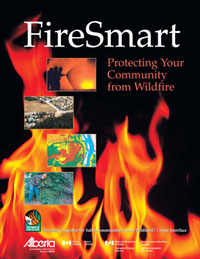
One of the first FireSmart guides was developed for communities - FireSmart: Protecting your Community From Wildfire” (Figure 2). The guide helps communities recognize and reduce fire-related threats from existing and future developments through better planning.
Saskatchewan has conducted wildfire risk assessments for over 100 communities. A sample wildfire risk assessment profile for Stanley Mission is portrayed in Figure 3 and 4. Individual Community Wildfire Risk Profiles are available on the Saskatchewan Environment Wildfire Risk Assessment website.
FireSmart hazard assessment guidelines have also been developed for property owners (Figure 5) and are available from Saskatchewan Environment (website or PDF). The guidelines can help commercial, residential and recreation property owners assess the wildfire hazards associated with their buildings or surrounding vegetation (Figure 6a & 6b).
-
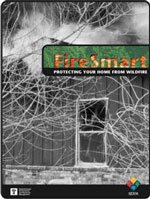 Figure 5: FireSmart Hazard Guidelines (PDF)
Figure 5: FireSmart Hazard Guidelines (PDF)
A variety of other educational materials are available from Saskatchewan Environment to help individuals reduce the risk of wildfire. These include videos, pamplets, and a variety of handouts dealing with specific topics such as:
All these measures are good adaptations to on-going and anticipated climate change in Saskatchewan’s forest areas.
Sources:
- Johnson, K, Maczek, P. and Fremont, L. (2007?): Saskatchewan Community Wildlife Risk Assessment Project – Final Report. http://www.environment.gov.sk.ca/adx/aspx/adxGetMedia.aspx?DocID=a9861404-d8df-4d98-8120- 27d831c839d4&MediaID=1714&Filename=Community+Wildfire+Risk+Assessment+Report.pdf&l=English [accessed January 25, 2011]
- Partners in Protection (2003): FireSmart : protecting your community from wildfire Second Edition http://www.partnersinprotection.ab.ca/downloads/ [accessed January 25, 2011]
- Saskatchewan Ministry of Environment (2008): Report on Saskatchewan’s Provincial Forest. http://www.environment.gov.sk.ca/adx/aspx/adxGetMedia.aspx?DocID=aee50778-4130-42d8-8a2e-377734026b0b&MediaID=1550&Filename=Report+on+Saskatchewan+Forests.pdf [accessed January 19, 2011]
- Saskatchewan Environment (2011): Wildfire Education and Prevention – FireSmart http://www.environment.gov.sk.ca/Default.aspx?DN=345cabaa-551e-437c-8122-292df6d38683 [accessed January 19, 2011]
